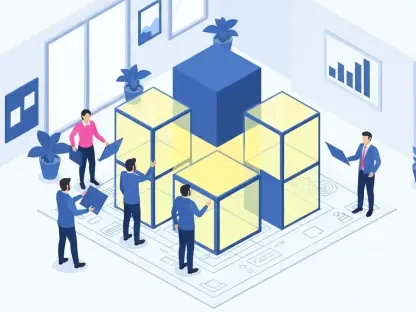Chloe Maraina is a visionary in the realm of data science and business intelligence, renowned for her skill in crafting compelling visual stories through big data analysis. In today’s discussion, she brings her unique expertise to explore the advancements Cisco has made under their CIO, Fletcher Previn, particularly the incorporation of AI to simplify internal processes and vastly enhance employee experiences.
What does being a “customer zero” entail for the Cisco IT team, and how does it benefit the company?
Being “customer zero” allows Cisco’s IT team to serve as the initial testers for new AI-driven systems, giving them firsthand experience with the technologies before they are rolled out more broadly. This role benefits the company by ensuring that these solutions are refined and optimized based on real-world usage, fostering innovation and providing valuable insights into potential improvements.
Can you elaborate on how AI is being integrated into Cisco’s internal platforms?
AI is being integrated into Cisco’s internal platforms by enhancing various operational aspects. This includes accelerating software development, optimizing processes, and transforming how employees interact with data. By embedding AI deeply within the enterprise infrastructure, Cisco is creating smarter systems that not only streamline tasks but also enrich the employee experience through more efficient workflows.
What are some specific examples of how AI tools have changed the way Cisco and its employees operate?
AI tools have dramatically reduced the time required for software development and operations tasks, transforming processes that once took hours into mere minutes. AI-assisted patch remediation and wireless optimization are now executed in real-time, leading to orders-of-magnitude improvements in productivity. Employees benefit from a significantly streamlined workflow, which as a collective performance boost across the company.
You mentioned that AI has shifted programming language needs. How is English becoming the next great programming language?
With AI advancements, machines are now learning to understand humans more intuitively. This shift positions English—or natural language—as a powerful way to command and configure AI systems. This evolution in communication means programmers can interface with machines without needing to rely on complex code, thereby democratizing and simplifying programming across the workforce.
How does AI simplify labor-intensive processes at Cisco, like patch remediation and wireless optimization?
AI simplifies these processes by automating and optimizing them in real time. Previously, tasks such as patch remediation required manual intervention and time-consuming checks. AI handles these efficiently, executing adjustments as frequently as every 30 minutes, drastically improving both the speed and accuracy of these processes without direct human involvement.
Since becoming CIO in 2022, what steps have you taken to simplify technology for Cisco employees?
Since assuming the role, steps have been taken to embrace AI as a core tool for simplifying work processes and enhancing the user experience. By automating repetitive tasks and integrating AI-driven solutions across the company, employees are freed from cumbersome manual processes, allowing them to focus on higher-level strategic tasks and enjoy a more intuitive interaction with technology.
How does AI democratize access to information and create a “white-glove experience” for all employees at Cisco?
AI democratizes access by enabling all employees to access high-level assistance and resources once only available to senior executives. Through intelligent process execution and real-time information retrieval, AI acts as a personal assistant for all, ensuring that each employee receives the tailored support necessary to maximize productivity and engagement at scale.
Can you describe the role and capabilities of Circuit, the AI assistant at Cisco?
Circuit serves as a versatile AI assistant that connects to various data sources and AI models to aid employees in their day-to-day tasks. From managing calendars and vacation requests to navigating HR systems, Circuit operates as a knowledgeable colleague, orchestrating complex workflows and facilitating smoother user interactions without requiring expertise in technical tools.
With multiple AI agents in use internally, how do you ensure they align with your simplification goals?
The strategy involves carefully designing agents to work transparently across systems, ensuring their roles streamline tasks rather than complicating them. While the initial introduction of numerous agents might appear complex, the long-term vision is that these will evolve, minimizing unnecessary interactions and empowering employees by instinctively completing tasks.
How do you anticipate the complexity of multiple agents will evolve as they become more capable?
As agents grow in sophistication, they will increasingly integrate seamlessly with operational workflows, reducing the need for direct employee engagement in routine tasks. This will simplify processes further, allowing individuals to focus more on defining their intents and objectives rather than managing intricate details, thereby fortifying productivity and reducing friction within operations.
How does Cisco approach AI security, especially in the context of defending against AI-driven threats?
In combating AI-driven threats, Cisco leverages AI itself to anticipate, identify, and counteract potential risks. The security framework is designed to match the rapidly evolving tactics of adversaries, using AI’s capabilities to strengthen defenses and maintain robust protection against increasingly sophisticated attacks, ultimately safeguarding the company’s assets and data integrity.
What advantages does Cisco have when it comes to building enterprise stacks, and how does AI enhance these components?
Cisco’s edge in building enterprise stacks lies in its extensive array of integrated products, from networking gear to advanced security and observability platforms. AI enhances these components by enabling smarter, more responsive systems that adapt in real-time to changing conditions, offering unparalleled insights and operational efficiency throughout the enterprise environment.
How do Cisco’s products like AppDynamics, ThousandEyes, Duo, and Umbrella contribute to your centralized telemetry and observability framework?
These products each contribute unique capabilities that feed into Cisco’s centralized telemetry framework, which aggregates vast amounts of data daily for real-time feedback and actionable insights. By leveraging these sophisticated tools, Cisco ensures that system activities are comprehensively monitored and optimized, maintaining high performance and security across the company.
How do you leverage AI to build an end-to-end SOC and create real-time reactions to enterprise activities?
AI is intricately woven into the fabric of Cisco’s SOC, providing critical support in processing data and delivering near-instantaneous responses to evolving conditions within the enterprise. This real-time alerting and action capability ensures that Cisco remains agile and responsive, safeguarding internal processes and facilitating adaptive management of enterprise activities.
What are some of the challenges you face in balancing rapid access to information with ensuring compatibility with Cisco’s values and risk management?
The main challenge lies in balancing the drive for immediate information access with the commitment to uphold the company’s values and mitigate risks. Ensuring that new technologies align with Cisco’s principles requires continuous evaluation, promoting transparency, ethical standards, and the protection of sensitive data while fostering innovation.
How do you and your team ensure that employees understand the technologies being used and the potential risks involved?
Education and open communication are crucial in ensuring employees are well-informed about the technologies they work with. This involves regular training sessions, informative resources, and fostering a culture of awareness around potential risks. By encouraging dialogue and expertise sharing, the team ensures employees remain informed and confident in navigating the evolving technological landscape.
Do you have any advice for our readers?
My advice for readers interested in the evolving landscape of AI in enterprises is to embrace continuous learning and adaptability. It is essential to understand that technology is moving rapidly. Staying informed, being open to new processes, and cultivating a proactive approach will help you harness these advancements productively and ethically.









